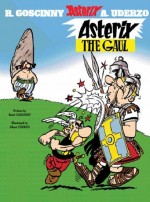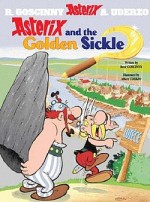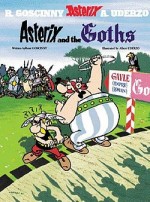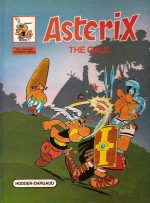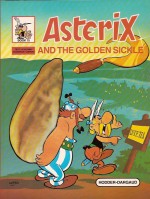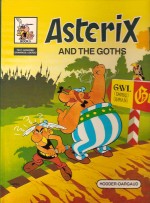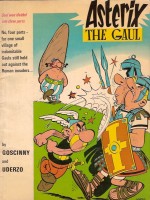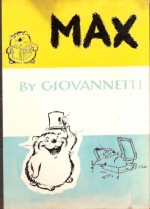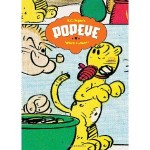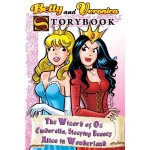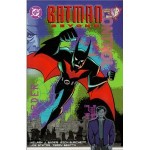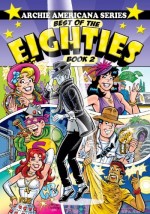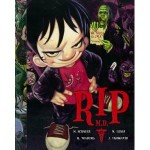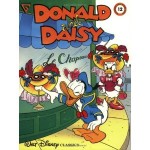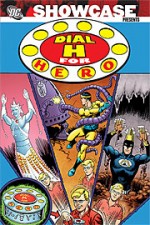
By Dave Wood, Jim Mooney & various (DC Comics)
ISBN13: 978-1-4012-2648-0
The entire world was going crazy for costumed crusaders in the mid-Sixties and every comicbook publisher was keenly seeking new ways to repackage an extremely exciting yet intrinsically limited concept. Perhaps its ultimate expression came with the creation of a teen-aged everyman champion who battled crime and disaster in his little town with the aid on a fantastic wonder-tool…
This slim monochrome compendium collects the entire run from House of Mystery #156 (January 1966) to #173 (March-April 1968) when the comicbook disappeared for a few months to re-emerge as DC’s first – of many – anthological supernatural mystery titles.
Created by Dave Wood and Jim Mooney, Dial H For Hero recounted the incredible adventures of boy genius Robby Reed who lived with his grandfather in idyllic Littleville where nothing ever happened…
Criminally, very little is known about writer Dave Wood, whose prolific output began in the early days of the American comics industry and whose work includes such seminal classics (often with artistic legends Jack Kirby and Wally no-relation Wood) as Challengers of the Unknown and the seminal “Space Race†newspaper strip Sky Masters.
A skilled “jobbing†writer, Wood often collaborated with his brother Dick, bouncing around the industry, scripting mystery, war, science fiction and adventure tales. Among his/their vast credits are stints on most Superman family titles, Batman, Detective Comics, World’s Finest, Green Arrow, Rex the Wonder Dog, Tomahawk, Blackhawk, Martian Manhunter and many others. As well as Dial H For Hero Wood created the sleeper hit Animal Man and the esoteric but fondly regarded Ultra, the Multi-Alien.
James Noel Mooney started his comics career in 1940, aged 21 and working for the Eisner & Eiger production shop and Fiction House on The Moth, Camilla, Suicide Smith and other B-features. By the end of the year he was a mainstay of Timely Comic’s vast funny animal/animated cartoon tie-in department.
In 1946 Jim moved to DC to ghost Batman for Bob Kane and Dick Sprang. He stayed until 1968, working on a host of features including Superman, Superboy, Legion of Super-Heroes, World’s Finest and Tommy Tomorrow, plus various genre short stories for the company’s assorted anthology titles like Tales of the Unexpected and House of Mystery.
He also drew Supergirl from her series debut in Action Comics #253 to #373, after which he headed for Marvel and stellar runs on Spider-Man, Marvel Team-up, Omega the Unknown, Man-Thing, Ghost Rider and a host of other features as both penciller and inker. Just before that move he was working on Dial H For Hero; the only original DC feature he co-created.
Big things were clearly expected of the new feature, which was parachuted in as lead and cover feature, demoting the venerable Martian Manhunter to a back-up role at the end of each issue.
The first untitled story opens with an attack on the local chemical works by super-scientific criminal organisation Thunderbolt just as Robby and his pals were playing in the hills above the site. As they fled the plucky lad was caught in a landslide and fell into an ancient cave where lay an obviously alien artefact that looked like an outlandish telephone dial.
After finding his way out of the cavern Robby became obsessed with the device and spent all his time attempting to translate the arcane hieroglyphs on it. Eventually he determined the writings were instructions to dial the symbols which translate to “Hâ€, “Eâ€, “R†and “Oâ€â€¦
Ever curious Robby complied and was transformed into a colossal super-powered “Giantboyâ€, just in time to save a crashing airliner and stop another Thunderbolt raid. Returning home he reversed the dialling process and went to bed…
These were and still are perfect wish-fulfilment stories: uncluttered and uncomplicated yarns hiding no great messages or themes: just straight entertainment expertly undertaken by experienced and gifted craftsmen who knew just how to reach their young-at-heart audiences, so no-one should be surprised at the ease with which Robby adapted to his new situation…
When Thunderbolt struck again next morning Robby grabbed his dial but was startled to become a different hero – high-energy being “The Cometeerâ€. Streaking to the rescue he was overcome by the raider’s super weapon and forced to use the dial to become Robby again. Undeterred, the lad tries again and as “The Mole†finally tracked the villains to their base and defeated them – although the leader escaped to become the series’ only returning villain…
Mr. Thunder was back in the very next issue as Robby became “The Human, Bulletâ€, bestial energy-being “Super-Charge†and eerie alien “Radar-Sonar Man†to crush ‘The Marauders from Thunderbolt Island’ whilst criminal scientist Daffy Dagan stole the H-Dial after defeating the boy’s temporary alter ego “Quake-Masterâ€. Dagan became a horrifying multi-powered monster when he learned to ‘Dial “V†For Villain’ but after the defeated hero took back the artefact Robby redialed into techno-warrior “The Squid†and belatedly saved the day.
Clearly the Mystery in House of… was related to where the Dial came from, what its unknown parameters were and who Robby would transform into next. Issue #159 pitted “The Human Starfishâ€, “Hypno-Man†and a super-powered toddler named “Mighty Moppet†(who wielded weaponised baby bottles) in single combats with a shape-changing gang of bandits dubbed ‘The Clay-Creep Clan’ whilst ‘The Wizard of Light’ played with the format a little by introducing a potential love-interest for Robby in his best friend’s cousin Suzy…
It also saw the return of Giant-Boy, the introduction of sugar-based sentinel of Justice “King Candy†and the lad’s only transformation into an already established hero – the Golden Age legend Plastic Man.
Cynical me now suspects the move was a tester to see if the Pliable Paladin – who had been an inert resource since the company had bought out original publisher Quality Comics in 1956 – was ripe for a relaunch in the new, superhero-hungry environment.
DC’s Plastic Man #1 was released five months later…
House of Mystery #161 featured an awesome ancient Egyptian menace ‘The Mummy with Six Heads’ who proved too much for Robby as “Magneto†(same powers but so very not a certain Marvel villain) and “Hornet-Man†but not the intangible avenger “Shadow-Manâ€, after which ‘The Monster-Maker of Littleville’ was proved by “Mr. Echo†and “Future-Man†to be less mad scientist than greedy entrepreneur…
‘Baron Bug and his Insect Army’ almost ended Robby’s clandestine career when the boy turned into two heroes at once; but even though the celestial twins “Castor and Pollux†were overmatched, animated slinky-toy “King Coil†proved sufficient to stamp out the Baron’s giant mini-beasts, whilst human wave “Zip Tideâ€, living star “Super Nova†and “Robby the Super-Robot†were hard-pressed to stop the rampages of ‘Dr. Cyclops – the Villain with the Doomsday Stare’.
Things got decidedly peculiar in #165 when a clearly malfunctioning H-Dial called up ‘The Freak Super-Heroes’ “Whoozisâ€, “Whatsis†and “Howzis†to battle Dr. Rigoro Mortis and his artificial thug Super-Hood in a bizarrely captivating romp with what looks like some unacknowledged inking assistance from veteran brush-meister George Roussos (who popped in a couple more times until Mooney’s departure).
Suzie became a fixture and moved into the house next door with ‘The King of the Curses’ who found his schemes to plunder the city thwarted by “TheYankee-Doodle Kid†and “Chief Mighty Arrowâ€, a war-bonneted Indian brave on a winged horse…
In HoM #167 ‘The Fantastic Rainbow Raider’ easily defeated “Balloon Boy†and “Muscle Man†but had no defence against the returning Radar-Sonar Man, whilst ‘The Marauding Moon Man’ easily overmatched Robby as “The Hoopster†but had no defence when another glitch turned old incarnations Mole and Cometeer into a single heroic composite imaginatively christened “Mole-Cometeerâ€, but the biggest shock of all came when ‘The Terrible Toymaster’ defeated Robby as “Velocity Kid†and Suzy cajoled the fallen hero into dialling her into the scintillating “Gem Girl†to finish the job.
As it was the 1960s, Suzy didn’t quite manage on her own, but when Robby transformed into the psionically-potent “Astro, Man of Space†they soon closed the case – and toybox – for good. This one was all Mooney and so was the next.
‘Thunderbolt’s Secret Weapon’ was also the artist’s last outing with the Kid of a Thousand Capes as the incorrigible cartel tried to steal a supercomputer only to be stopped dead by “Baron Buzz-Sawâ€, “Don Juan†(and his magic sword) and the imposing “Sphinx-Manâ€.
With House of Mystery #171 a radical new look emerged, as well as slightly darker tone. The writing was clearly on the wall for the exuberant, angst-free adventurer…
‘The Micro-Monsters!’ was illustrated by Frank Springer and saw Robby dial up “King Viking – Super Norsemanâ€, “Go-Go†a hipster who utilised the incredible powers of popular disco dances (how long have I waited to type that line!!!?) and multi-powered “Whirl-I-Gig†to defeat bio-terrorist Doc Morhar and belligerent invaders from a sub-atomic dimension.
Springer also drew ‘The Monsters from the H-Dial’ wherein the again on-the-fritz gear turned his friend Jim into various ravening horrors every time Robby dialled up. Luckily the unnamed animated pendulum, Chief Mighty Arrow and “the Human Solar Mirror†our hero successively turned into proved just enough to stop the beasts until the canny boy could apply his trusty screwdriver to the incredible artefact again.
In those distant days series ended abruptly, without fanfare and often in the middle of something… and such was the fate of Robby Reed. HoM#173, by Wood and Sal Trapani saw the lad solve a mystery in ‘The Revolt of the H-Dial’ wherein the process turned him into water-breathing “Gill-Man†and a literal “Icicle Manâ€: beings not only unsuitable for life on Earth but also compelled to commit crimes. Luckily by the time Robby had become “Strata Man†he’d deduced what outside force was affecting his dangerously double-edged dial…
And that was that. The series was gone, the market was again abandoning the fights ‘n’ Tights crowd and on the horizon was a host of war western, barbarian and horror comics…
Exciting, fun, engaging and silly in equal amounts (heck, even I couldn’t resist a jibe or too and I genuinely revere these daft, nostalgia-soaked gems) Dial H For Hero has been re-imagined a number of time since these innocent odysseys first ran, but never with the clear-cut, unsophisticated, welcoming charm displayed here.
This is Ben-10 for your dad’s generation and your kid’s delectation: and only if they’re at just that certain age. Certainly you’re too grown up to enjoy these glorious classics. Surely you couldn’t be that lucky; could you…?
© 1966, 1967, 1968, 2010 DC Comics. All rights reserved.

